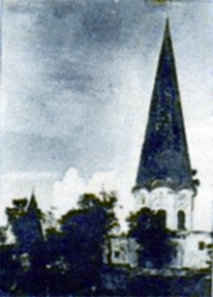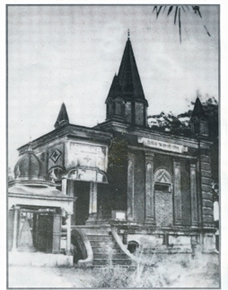Ramna Kali Mandir
Ramna Kali Mandir and Ma Anandamoyee Ashram existed on the southern side of Suhrawardy Udyan in Dhaka covering an area of 2.22 acres of land. This Temple is also known as 'Kalibari' (house of Goddess Kali)built about 300 years ago and was located beside the present dighi (pond) inside the Suhrawardy Udyan. The Kali Mandir (temple) is said to have been built by a group of pilgrims who were the followers of Sankaracharya. It was nearly five hundred years earlier that a saint of Yoshi Matha of Badri Narayan named Gopal Giri came to Dhaka and built a monastery. The monastery was then known as 'Kathgarh'. Subsequently (probably in the early seventeenth century), the main temple was built here by Haricharan Giri. This temple was destroyed on 27 March 1971 by the Pakistan occupation army. They set the temple and the axram on fire. Nearly one hundred mendicants including the caretakers of the temple, the devotees and the people residing there in were killed. Sreemat Swami Paramananda Giri was then the priest of the temple.
Although the temple built beside the old akhra by Haricharan Giri represents the Hindu style of architecture, the influence of Muslim style is also noticed. The main temple was two storied. On its roof there was a 120 feet high pyramid shaped peak. The main temple was square in shape with elevated roof built in hut-type chowchala style of Bengal. It is learnt from the documents that in the late sixteenth century kedar rai, zamindar of Vikrampur and Sreepur built this temple for his guru. The lower portion of the cubic shaped pick was decorated by umbrella type design. It can be compared with ek-ratna (one jewel) temple. There existed the structure of a number of old and new memorial temples in the premises. In this courtyard was the cemetery of Haricharan and Gopal Giri.

The earliest photograph of the entrance gate of Ramna Kali Mandir belongs to the late nineteenth century. The temple was then surrounded by brick walls. A new entrance gate was then built on the southern side. Inside the temple premises on the left was the remnant of a square structure. In its center was a platform where the old temple existed. The statue of goddess Bhadrakali seated on a beautiful wooden throne was placed in the temple surrounded by walls. The statue of goddess Kali from Bhawal stood on the right hand side of this statue. The residential quarters of the priests, attendants and the devotees stood on the north-east and west side of the temple. A Shiva Mandir also existed nearby. There was a hall for devotional dancing and music (Nat-Mandir) and an entrance gate.

The dighi in front of the Kalibari is said to have been excavated by Rani Bilasmani of Bhawal. But some documents of the British period indicate that the English Magistrate D’os excavated the dighi. Probably the dighi was re-excavated by Rani Bilasmani of Bhawal. At present, this dighi is the only extant remains of the Ramna Kali Mandir. Anandamoyee Ashram was situated on the northern side of Kali Mandir. Anandamoyee was a mendicant and the wife of Ramani Mohan Chakrabarty, the caretaker of Shahbagh Garden of the Nawab of Dhaka. Ma Anandamoyee earned fame for her spiritual power and was venerated as a saint. Her devotees built two monasteries, one at Ramna and the other at Siddheswari Kalibari. The entrance gate of the Anandamoyee Ashram was on the eastern side. There was a Nat Mandir on the west. Inside a room on its north was preserved the lotus-feet of Ma Anandamoyee. The statues of Vishnu and Annapurna were installed on the altar of the temple. Other than the sannyasis and devotees, a number of professional group of people used to live with their families inside the compound of the Kali Mandir, and they used to attend the functions and ceremonies arranged in the temple and Ashram.
The Sri Sri Kali Mandir and Sri Ma Anandamoyee Ashram have been rebuilt anew on the ruins of the old structure. The main entrance gate of the temple is now on the northern side of the dighi. Outside the main gate stands an epitaph with the names of the martyrs' victim of the genocide of the Pakistan occupation army on 27 March 1971. Inside the campus after the main entrance are few other temples, such as Sri Sri Durga Mandir, Sri Sri Radha-Govind Mandir, Sri Sri Lokhnath Brahmachari Mandir (under construction), Sri Sri Anandamoyee Mandir Ashram (under construction), Sri Sri Harichand Mandir (under construction) and two statues of God Shiva. [Fazilatun Nessa]
Bibliography AH Dani, Dhaka A Record of its Changing Fortunes, Dhaka, 2009; Report on the Public Inquiry Commission on 'Destruction of Ramna Kali Temple and Ma Anandamoyee Ashram and Mass Killing, 2000.
